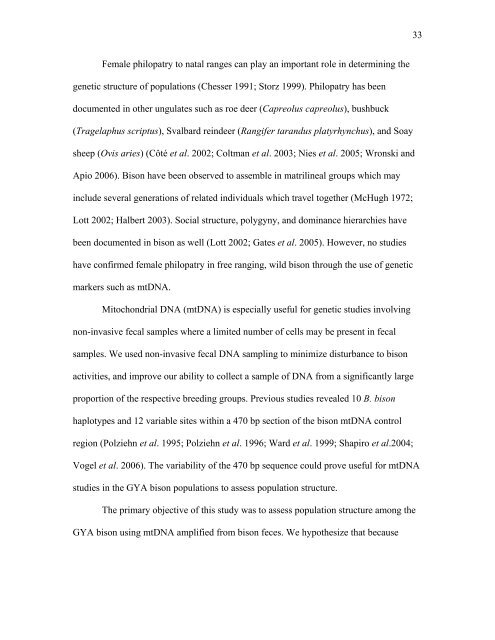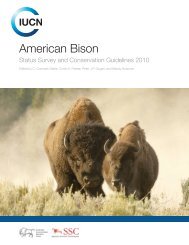Declaration Dr. Thomas H. Pringle - Buffalo Field Campaign
Declaration Dr. Thomas H. Pringle - Buffalo Field Campaign
Declaration Dr. Thomas H. Pringle - Buffalo Field Campaign
Create successful ePaper yourself
Turn your PDF publications into a flip-book with our unique Google optimized e-Paper software.
Female philopatry to natal ranges can play an important role in determining the<br />
genetic structure of populations (Chesser 1991; Storz 1999). Philopatry has been<br />
documented in other ungulates such as roe deer (Capreolus capreolus), bushbuck<br />
(Tragelaphus scriptus), Svalbard reindeer (Rangifer tarandus platyrhynchus), and Soay<br />
sheep (Ovis aries) (Côté et al. 2002; Coltman et al. 2003; Nies et al. 2005; Wronski and<br />
Apio 2006). Bison have been observed to assemble in matrilineal groups which may<br />
include several generations of related individuals which travel together (McHugh 1972;<br />
Lott 2002; Halbert 2003). Social structure, polygyny, and dominance hierarchies have<br />
been documented in bison as well (Lott 2002; Gates et al. 2005). However, no studies<br />
have confirmed female philopatry in free ranging, wild bison through the use of genetic<br />
markers such as mtDNA.<br />
Mitochondrial DNA (mtDNA) is especially useful for genetic studies involving<br />
non-invasive fecal samples where a limited number of cells may be present in fecal<br />
samples. We used non-invasive fecal DNA sampling to minimize disturbance to bison<br />
activities, and improve our ability to collect a sample of DNA from a significantly large<br />
proportion of the respective breeding groups. Previous studies revealed 10 B. bison<br />
haplotypes and 12 variable sites within a 470 bp section of the bison mtDNA control<br />
region (Polziehn et al. 1995; Polziehn et al. 1996; Ward et al. 1999; Shapiro et al.2004;<br />
Vogel et al. 2006). The variability of the 470 bp sequence could prove useful for mtDNA<br />
studies in the GYA bison populations to assess population structure.<br />
The primary objective of this study was to assess population structure among the<br />
GYA bison using mtDNA amplified from bison feces. We hypothesize that because<br />
33










